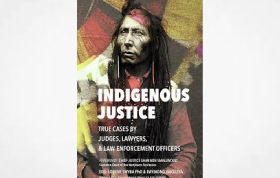Several times each month, we are pleased to republish a recent book review from the Canadian Law Library Review (CLLR). CLLR is the official journal of the Canadian Association of Law Libraries (CALL/ACBD), and its reviews cover both practice-oriented and academic publications related to the law.
Indigenous Justice: True Cases by Judges, Lawyers, and Law Enforcement Professionals. Edited by Lorene Shyba & Raymond Yakeleya. Calgary: Durvile & UpRoute Books, 2023. xi, 275 p. Includes index. ISBN 9781990735264 (softcover) $35.00.
Reviewed by Leslie Taylor
Research & Instruction Librarian
Lederman Law Library
Queen’s University
Indigenous Justice is a collection of stories and essays written by legal and law enforcement professionals, both Indigenous and non-Indigenous, who have worked with First Nations, Inuit, and Métis people in the Canadian criminal justice system. Edited by Lorene Shyba, PhD, and Dene filmmaker and writer Raymond Yakeleya, Indigenous Justice is the newest book in Durvile’s True Cases Series. Durvile & UpRoute Books is an independent press located in Calgary, Alberta, that publishes books with a focus on true cases, biographies, and Indigenous literature.
The book has three parts, each containing chapters written by members of a specific profession: judges (and a senator) in Part I, lawyers in Part II, and law enforcement and parole officers in Part III. The chapters are in memoir style and are therefore largely based on individual experiences. In some cases, they are supplemented by external research.
While the chapters in Indigenous Justice cover a range of perspectives and topics, common themes emerge throughout the book. One theme is the injustice experienced by Indigenous People in the Canadian criminal justice system. Although stories of injustice and suffering may be distressing to read, Chief Justice Shannon Smallwood explains, “Only by learning about the experiences of Indigenous People in the criminal justice system in the past can we move forward” (p. xi).
The injustices recounted in this book are numerous and varied, and while some took place in the more distant past, others continue today. Despite the variety of content, what all the stories have in common is the existence of racism and discrimination within the Canadian criminal justice system. In “The Story of S: A Study in Discrimination and Inequality,” the Honourable Kim Pate discusses the factors contributing to the gross over-representation of Indigenous women in Canadian prisons. In “Treaty Lessons: The Killing of Colten Boushie,” Eleanore Sunchild, KC, tells of the systemic racism she witnessed in the court system while supporting the family of Colten Boushie during the trial of Gerald Stanley. And, in “There is No Law Against It Constable,” Ernie Louttit recounts his experiences in the 1980s confronting indifference and apathy within the Saskatoon Police Service toward addressing the problem of solvent abuse among Indigenous youth. These are just a few examples of the many stories illustrating the injustices faced by Indigenous People in the criminal justice system.
In general, the book presents the implementation of culturally appropriate processes and programs as a way for the Canadian criminal justice system to move forward in its interactions with Indigenous People. Although many of the chapters contain darker themes of suffering and injustice, there are also positive themes in the book. One such theme is recovery and rehabilitation through the discovery and implementation of Indigenous knowledge and cultural practices; for example, several chapters contain accounts of Indigenous inmates who have found healing by participating in restorative justice and other culturally relevant programs within the prison system. Other chapters focus on the experiences of legal practitioners who have facilitated or participated in sentencing circles and other restorative justice practices, and who advocate for their continuation and enhancement across the country. Other chapters focus on innovative programs that seek to restore relationships between Indigenous communities and the justice system, such as the Human-Centred Engagement and Liaison Partnership (HELP) unit of the Edmonton Police Service, which pairs police officers with Indigenous navigators to provide support to vulnerable people in the community.
This book succeeds in raising awareness of the historic and ongoing injustices experienced by Indigenous People in the Canadian criminal justice system, as well as in showing a way forward with culturally appropriate processes and programs. The fact that the authors come from all levels of the criminal justice system exposes the widespread and systemic nature of the problems. The first-hand accounts are both compelling and easy to read, making the book accessible and engaging for a variety of readers.
I recommend Indigenous Justice to any library that supports educational institutions that train future legal and law enforcement professionals. In addition, public libraries should consider acquiring this book to provide the public with an opportunity to learn about the experiences of Indigenous People in the Canadian criminal justice system. A percentage of the proceeds from the purchase of the book goes to the Stardale Women’s Group and Esquao Institute for the Advancement of Aboriginal Women.





